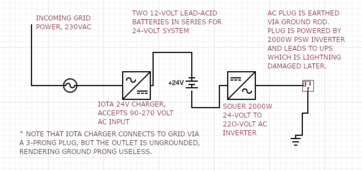don't use the Ethernet coming off the antenna as the lightning path going into the house then the modem where it plugs in the wall outlet. That will get cooked. You need to ground the ethernet via surge suppressor at the pole that is tied back to utility ground. Pole, ethernet surge arrestor, and utility ground (main house ground) are all at the same potential.
I may be wrong but your saying may be why my wifi and the other grey box keep getting fried..5 times now…..everytime we have a close lightning strike anywhere near me..
DISCLIMER: This is not my work…this was all done by “ professional “ people who charge a lot…!
.the internet equipment is all in my tool shed ( hooked up by the high priced phone Co dude) .
the shed and it’s sub panel is wired 70 ft back to the main house ( by a high priced electrician) .
The shed sub panel does NOT have a seperate grounding electrode but is grounded back to the house main system underground with the other wires…
..The phone internet equipment is plugged into the sheds electric service inside the shed at an outlet.
There is a green phone utility box directly under the utility power pole about 30 feet from the shed which feeds underground wire directly to the internet box in the shed . It is not wired to the subpanel , just the internet gear.
I “suspect” but am not positive the green phone co box wire feeding my internet gear is tied to a ground rod or an equivalent out by by the utility pole..
.I DO know the internet gear also is plugged into the ac outlet tied back to the main house though the shed sub panel and has a totally different ground electrode than the green box
100 ft apart…
When lightning ( or a surge is present) it always seems to come in on the line from the green box (fry the phone gear)… take out my wireless router , ..go into to the ac outlet ,trip the gfic circuit at that outlet and stop without and damage past the outlet.. everytime.. no damage but to internet gear..
Is two shared seperate grounds connected to one system the problem…?
IS the phone wire coming out of the green utility box , ( as you said) acting as an antenna bringing in the surge into the phone/ internet gear the issue..?
Why is the GFIC always trip .? I thought that was for imbalance between the hit and nuetral..?
The only other thing I can mention that “might” be an issue is my “high priced electrician” left all the neutrals and ground wires still bonded at the shed subpanel when the shed was moved here from a standalone location.. (multiple nuetral/ ground points ) ..they were never separated at the bussbars or the green screw..
That was before I got into solar and learned a little about bonding
Oh and by the way My high priced electrician ran off and disappeared ..!
As you suggested in your comment If I did put a SPD on the system, where would you even hook it to..the phone company’s green green box outside …?
also which ground would you choose .(.ha ha ha ) to connect it to…?
Like I said , I did none of this work …..When I do stuff it generally works right…and it doesn’t blow up once a year.
J.





